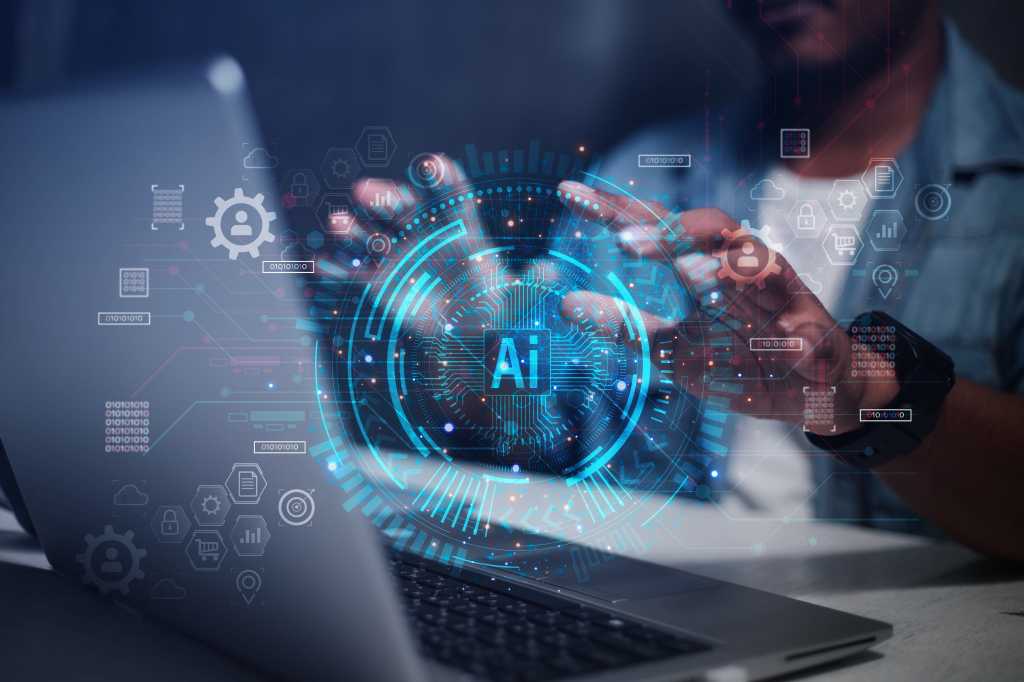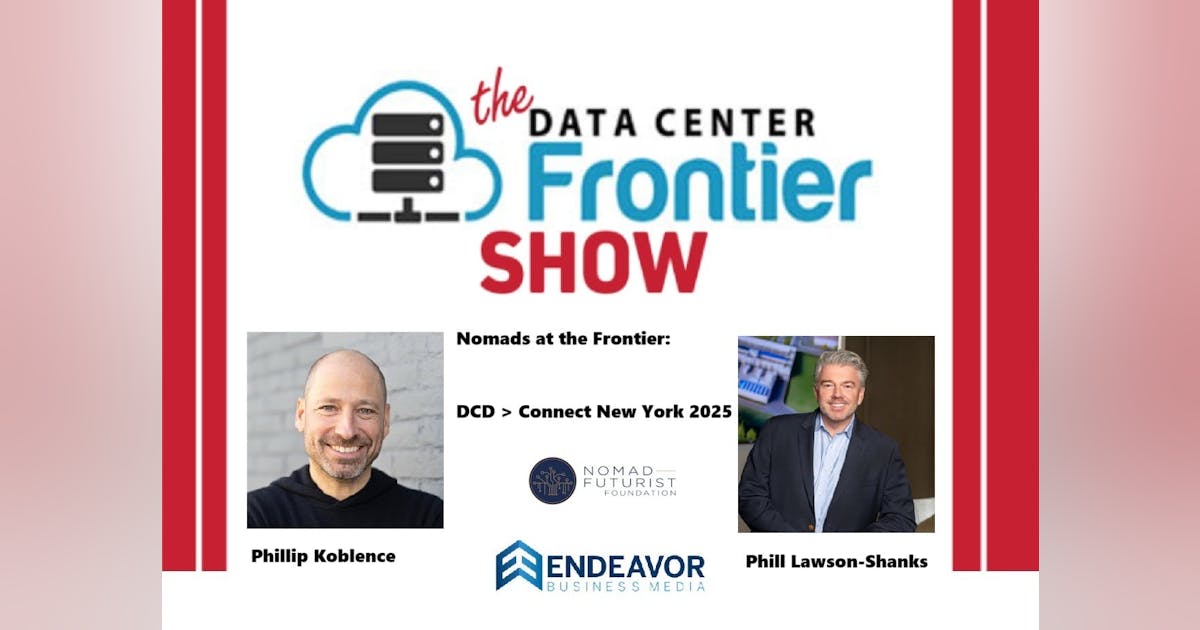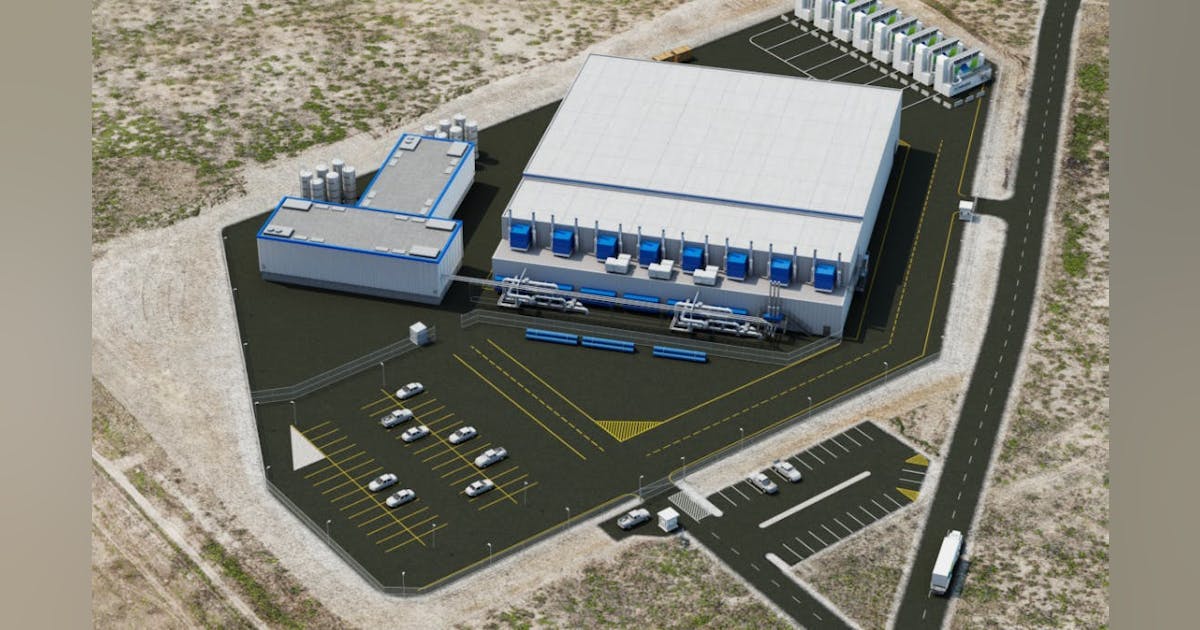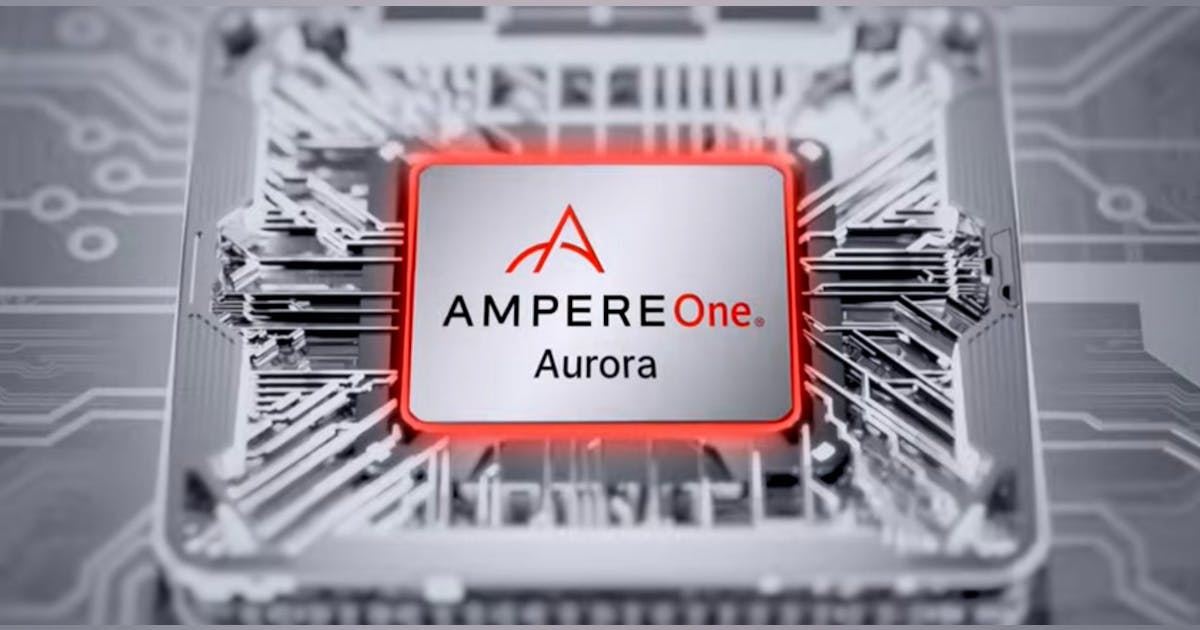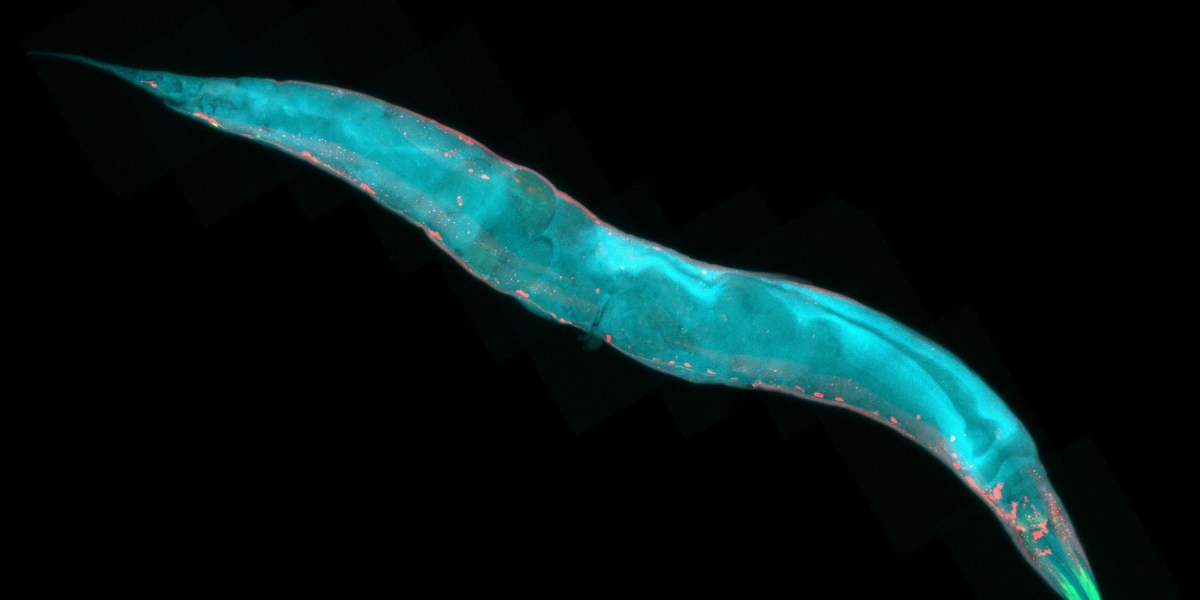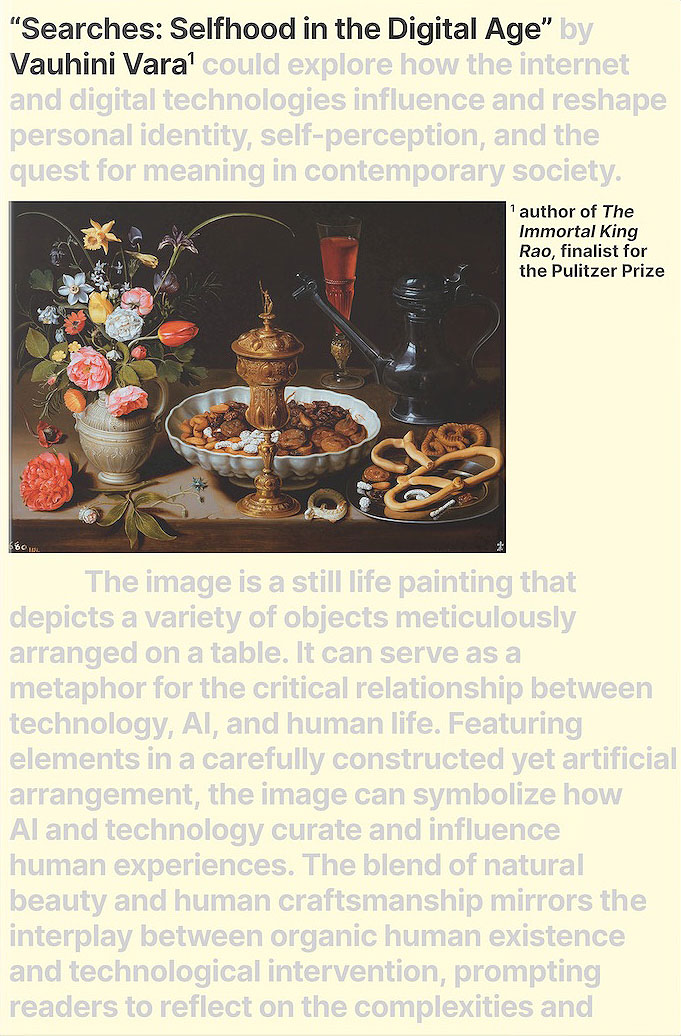Genies has been investing heavily for this moment. The culture-focused avatar technology company is revealing its user-generated content tools that let anyone create custom AI avatars.
Genies raised $150 million in 2022, and it has been busy ever since building out the tech stack for what it calls Parties, or gaming platforms driven by AI avatars, user-generated content, and personalized gameplay.
In an exclusive interview, Genies CEO Akash Nigam gave GamesBeat a look under the hood at Genies’ technology that has been in the works for years with the hope of powering the next generation of digital experiences. While the tech is established, Nigam has never shown it off to a journalist before.
“As you can see, the quality of it is very high. As far as just like the different kinds of business model that you could entertain here, you can foresee something like a commission fee or something like that for people who are creating these things,” Nigam said. “I can’t reveal the partners that we have onboarded, but they are tier one. They’re like the biggest ones in entertainment and gaming.”

Nigam said the company was driven by the mantra where anyone should be able to create anything. Genies’ tech has a suite of UGC tools that allow anyone to create any type of AI avatar (including fashion, props, behaviors, and personalities) and AI avatar experiences.
Everything created should also work with everything else, Nigam said. The stack includes the Genies’ Avatar Framework which uses machine learning and computer graphics to ensure interoperability and compatibility across all user generated AI Avatars and AI Avatar experiences with limitless creativity.
“We have bet the business on these mantras,” Nigam said. “The reason why we have done this is because we believe we know where the future of the Internet is going. We believe the future of the Internet is going to be an intersection of three main trends: AI, XR and gaming.”
The combination of these mantras not only enables individuals to create limitless experiences, but also allows intellectual property owners to foster social gaming ecosystems driven by UGC and AI Avatars – these interoperable ecosystems are what Genies calls Parties.
Nigam said he thought back to a question that I asked him 2019. He recalled, “You asked, ‘Why do you want to make a bet on avatars?’ And the biggest reason why we made a bet on avatars is because we believe that it’s a prerequisite for the future of the Internet. If you imagine AI XR and gaming all forming this new medium, an avatar is a prerequisite. You’re not going to talk to just a chat bot or chat 24/7 with an AI persona. You need some 3D asset of gaming, and avatars have been core to gaming forever. We knew that this was going to grow and eventually become your own experiences.”
Early adopters of Genies’ first gen avatars include icons like Justin Bieber, Rihanna, J Balvin, Migos, and thousands more. With offices in Los Angeles and San Francisco, Genies has raised $200 million to date from notable investors including Silver Lake, BOND, NEA, and Bob Iger.
The mission and the vision
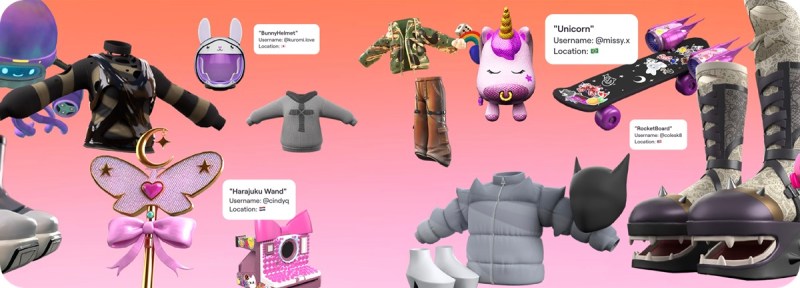
Genies is dedicated to powering the digital identity layer for next generation experiences. As AI, gaming, and XR converge to represent the internet’s future, Genies avatar technology acts as the connective tissue at this intersection. Genies seeks to create a world where digital identity, UGC, and AI-driven avatars define the next generation of mobile apps: personalized, adaptive, smart, social gaming experiences.
This marks the culmination of over five years of technological advancements, Nigam said.
Genies first took off during the pandemic, when celebrities couldn’t meet their fans in person. But those celebrities could create 3D avatars that they could use to make voice-based appearances at virtual events where they could entertain fans or otherwise meet with them in online settings.
Soon, thousands of celebrities caught on and created a new revenue stream that has persisted even after the pandemic. It’s like how musicians found they could make a lot of money with music concerts in the wake of Spotify and Napster drying up record sales.
How far is this going to go?
“Increasingly, you’re not going to show up as Dean Takahashi. You’re going to show up as a avatar of yourself that represents your personality as well,” he said. “In 2025, we’ve seen personalized LLMs and the need for these ‘AI companions’ dramatically increase. And so people are starting to move into the applications of AI and people are starting to even say statements like, you know the average number of AI friends that you will have in the next five years is going to be greater than the number of real friends, right?”
While AI companions are pretty static now, Nigam believes that will become much more lively. You will be able to chat with them, but they will also become “game ready,” he said.
“They will be an asset you can play with,” he said. “Think of Gen Alpha. Gen Alpha doesn’t synchronously hang out together on Instagram. They hang out together in places like Roblox, like Fortnite, like these open world platforms. This is how you speak their language, right? You don’t build a relationship with Gen Alpha unless you let them interact with you and your UGC.”
If there’s a company out there that is similar, Nigam believes it’s Epic Games, as Tim Sweeney has painted a picture of the metaverse many times and he too foresees the intersection of AI, XR and gaming.
“They also believe that everybody’s going to use UEFN to create these Fortnite worlds where people hang out,” Nigam said.
Nigam said Genies is focused on open source, driven by AI avatars, UGC tools and interoperable frameworks.
“When you break down what exactly we’ve created, it was really under this premonition where we feel like everybody is going to be moving into this new medium,” he said.
And not every company will get $1.5 billion handed to them, as Disney gave to Epic. But Genies is positioning itself to work with many possible partners.
Understanding the shift in digital interaction

Today’s social media landscape is a space where people primarily consume media rather than actively engaging in social interactions. Traditional platforms like Instagram have become one-sided, with brands and users broadcasting content into a passive abyss.
However, UGC-driven gaming platforms like Roblox and Fortnite have emerged as dynamic social spaces where users can authentically express themselves, hang out, and connect in real-time. These “two way dialogue” and UGC spaces have become extremely popular with Gen Alpha and Gen Z, Nigam said.
This generational shift underscores the rise of Parties, Genies’ response to the demand for deeper, two-sided digital interactions. With UGC and interoperability at the core, Parties enable brands and audiences to co-create, interact, and engage in ways never seen before.
Building a relationship between IP and the next generation looks similar to what Disney and Epic announced in 2024, where Disney will create social spaces inside Fortnite worlds where its characters can interact with fans in a gaming environment.
Building a meaningful relationship with Gen Alpha requires a deep understanding of their digital habits, preferences, and social behaviors. Unlike previous generations, Gen Alpha is growing up in an era where digital interactions and personalization shape their experiences.
To connect with them effectively, it is essential to speak their language, using the cultural references, trends, and digital dialects that resonate with them. Meeting them where they naturally engage is just as critical—this means immersing in their digital environments, such as gaming platforms, social networks, and virtual worlds.
What’s a Party?
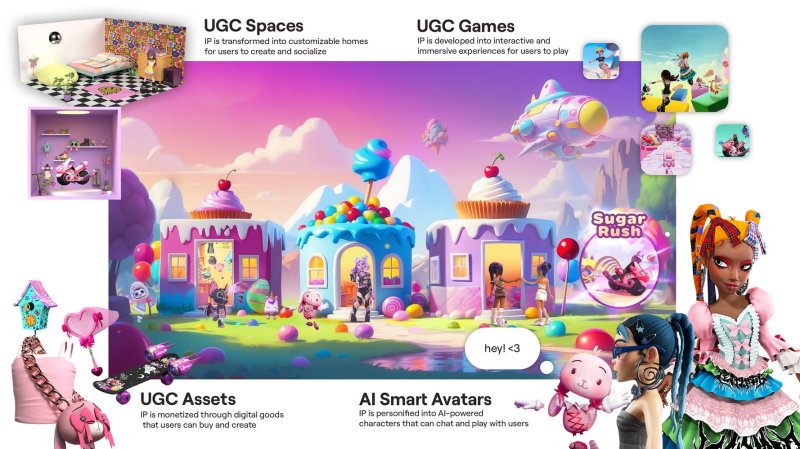
A Party is a next-generation UGC gaming ecosystem that enables IP owners to create fully customizable mobile platforms powered by AI avatars, personalized gameplay, and user-generated content. With a Party, IP owners and creators can transform user engagement from passive consumption into active co-creation—enabling IP owners to build unique and personalized relationships with their users through AI, while empowering users to play a role in creating the future of the brand.
Nigam said the company has a number of big clients, but it can’t disclose any of its current IP partners yet. So the Party visuals in this story the written examples listed below highlight a make-believe IP called “Candy Party” in order to help contextualize how this could work for any real IP.
At its core, a Party is built on three key pillars: smart avatars, user-generated content (UGC), and interoperability.
Smart avatars: Smart avatars are AI-powered digital characters with distinct personalities, behaviors, and aesthetics designed to drive meaningful engagement through intelligent interactions – serving as the heart of any Party. Built on large language models (LLMs) and behavioral AI, they are far more than chatbots—they are intelligent, expressive, and adaptive game ready assets that can engage in real-time conversations and participate in dynamic game-play with users.
Smart avatars aren’t just visually customizable—they think, learn, express, and interact in a way that makes them truly alive in digital spaces. The brain of each avatar allows for AI-driven gestures, real-time reactions, and voice utilizing AI synthesis. While in play, AI-driven physics enable seamless movement and interaction.
Example use case for Parties: For existing IP, talent IP, or even new IP, smart avatars bring characters or personas to life, allowing them to interact, build relationships, and dynamically play with users throughout Party experiences. Imagine a candy store IP launches their own Candy Party, they could transform their Bubblegum Bunny mascot into personified AI smart avatars that embodies its cute personality, silly expressions, and subtle gestures to dynamically chat and play games with users.
Developers can then leverage these IP-based smart avatars to create and launch UGC games with them in Candy Party. In addition to IP-driven smart avatars, every user also generates their own unique smart avatar, which becomes a hyper-customized AI companion that can be used as a game-ready asset for dynamic play within Party experiences, along with personalized conversations for advice, friendly banter, insights, and more.
Core tech that enables smart avatars
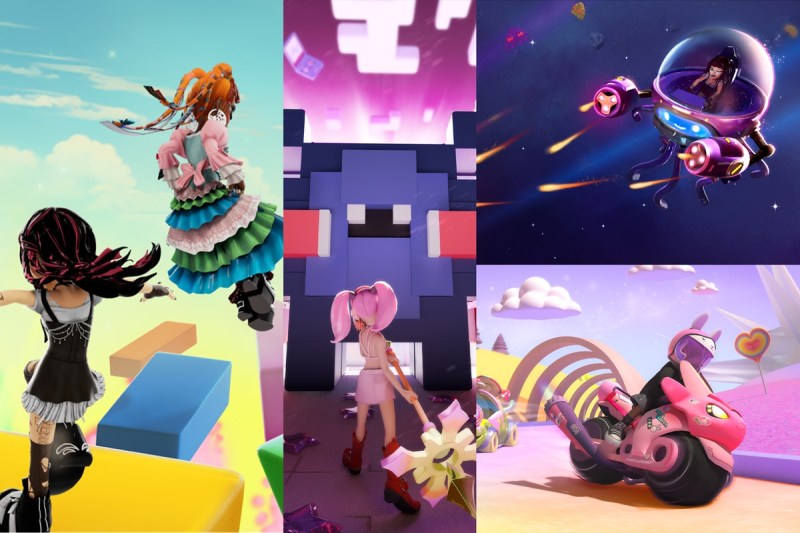
Autogeneration and AIGC avatar creation: With Genies’ Avatar Autogeneration tool, any user can automatically generate a stylized 3D avatar that resembles their likeness through uploaded images. This enables seamless avatar creation so users can generate a highly appealing, stylized avatar that looks just like them that they can bring with them into Parties, without needing any kind of technical expertise.
Through Genies’ AIGC creation tool, users can also generate any bipedal avatar through text prompts, enabling them to create even more fantastical avatars that they can use in Parties, such as animals, creatures, or characters.
Avatar customization & compatibility: A robust customization system allows users to modify every aspect of their avatar, from facial structure to clothing layers, ensuring every avatar is unique and fully compatible with different visual styles. Once an avatar has been generated, users can continue to customize specific details—including the face, skin color, body shape, hairstyle, makeup, tattoos, clothes, and accessories—to give them more control over the look and feel of their avatar.
AI persona creation: Once the look of a Smart Avatar has been created, they can be trained with AI to develop their own unique personalities, which unlocks dynamic conversations and gameplay for users throughout Party experiences.
Behavioral AI: Using sentiment analysis, Smart Avatars can animate in real time, reacting with synchronized gestures, expressions, and movements based on gameplay or conversation. This gives them a more personalized, life-like behavior, enabling them to smile, laugh, frown, wave, or even facepalm in real time based on the context of their conversations and interactions.
UGC custom animation pipeline: Users can capture real-world movements through face and body tracking to generate personalized animations for any avatar. Using built-in smartphone sensors or uploading videos from their camera roll, anyone can use Genies Camera to bring avatars to life with expressive animations, emotes, and gestures to truly customize their behaviors in Parties.
AI smart avatar demo
User-generated content (UGC): Communities can actively shape their Party experience by creating games, digital goods, and avatar customizations, fostering deeper user participation. Parties thrive on a continuous influx of user-generated games, avatars, and digital goods. While IP owners retain control over content moderation, communities actively shape the experience, enhancing both engagement and loyalty. Genies’ UGC tech is driven by their mission of enabling anyone to create anything, empowering creators of any skill level to create.
Example use case for Parties: IP Owners can provide their users with Genies’ UGC tools to unlock an infinite supply of custom assets and games for their Party, empowering fans and creators to utilize their IP in unique ways and co-create with the brand. Imagine a creator generating their own custom stylized Bubblegum Bunny purse and Cupcake dress that their avatar can wear or CandyRush wand their avatar can hold. Imagine a developer can create a Sugar Rush racing game that incorporates Bubblegum Bunny’s Smart Avatar, allowing fans to play together in Candy Party.
He said that Parties consist of smart avatars, UGC games, and UGC assets.
“We want to decrease the barrier to entry. We have a developer kit. We have our dev platform tools for people to use to create heightened experiences. We want there to be a no code way, so that a 16 year old fan of an IP can take our building blocks generate a really meaningful game,” he said. “If someone wants to create something in an anime style, they can. If somebody else wants to create something in a Pixar style, in a completely different shape and size, they can. Those two need to be able to intersect with each other. And that’s all about UGC, all about interoperability. At the center of it all are smart avatars.”
Core Tech That Enables UGC
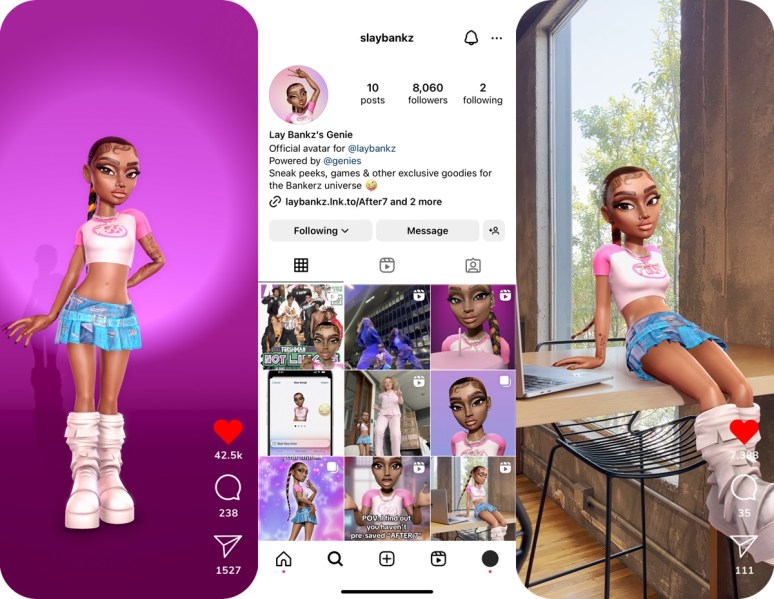
UGC Assets
AIGC Asset Pipeline: AI-generated content (AIGC) tools allow users to create 3D assets using simple text or image prompts. This minimizes technical barriers, allowing users to produce high-quality digital fashion, props, accessories, or even avatars that they can use throughout Party experiences.
DIY Fashion Tools: A sophisticated set of fashion editing tools enable users to modify and customize fashion items, changing textures, adding embellishments, or even layering multiple pieces for truly unique digital fashion creations.
UGC Games
Experiences SDK + No Code Development Tools: Equips developers and creators with the essential tools to create and launch Smart Games that support UGC and interoperability. This enables real-time avatar interactions, seamless multiplayer gameplay, and persistent identity across Party experiences.
Genies Experiences SDK allows developers to publish games directly into any Party app, making it a “super app” (everyone’s own Roblox). Genies no code development tools will enable users of all skill levels to create and launch custom, personalized mini games through a chat first experience, leveraging Genies’ AIGC and Smart Avatar technologies.
XR compatibility: Expands creative possibilities by supporting immersive XR experiences on mobile and wearable devices.
Interoperability: To unlock the full potential of a scalable, thriving UGC ecosystem, Genies’ frameworks are built for seamless compatibility and interoperability across all assets and experiences. Interoperability ensures that any user-generated creation can work effortlessly with any avatar, experience, or Party, driving their mission of everything works with everything.
Genies’ Avatar Framework leverages machine learning and computer graphics to provide limitless customization and compatibility of AI avatars, experiences, fashion, props, and more. Whether you’re a developer integrating avatars into your game or a creator designing digital fashion and props, Genies’ framework ensures that your creations seamlessly adapt and function across different experiences, environments, aesthetics, and platforms.
Example use case for Parties: Once a user designs their custom Bubblegum Bunny purse, CandyRush wand, or Cupcake dress, these assets are automatically prepared by our system to be used across different avatars, environments, and experiences. The Cupcake dress may originally be created for a human-like avatar, but then can automatically adjust to fit a troll-shaped avatar, reshaping itself seamlessly.
A pair of cybernetic wings built for a robot figure effortlessly adapts to work on a polar bear avatar. That’s interoperability in action. A user can also take that outfit or prop designed for their Candy-style looking game and bring it into an anime-style looking experience where each item will automatically alter its look to match the new aesthetic. This gives your creations more utility and value since you can use them throughout a wider range of experiences and Parties.
Core tech that enables interoperability
AutoRigging: After generating any 3D asset with Genies AIGC tools or creating from scratch, users can automatically convert their asset into a fully-rigged, game-ready asset. Whether it’s a wearable, an avatar, or an interactive prop, the system adapts assets to seamlessly integrate across different Party environments without requiring manual rigging or adjustments.
Prop Retargeting: Genies prop retargeting technology automatically adjusts all assets, enabling them to be equipped by or interacted with all avatars and seamlessly carried across Party experiences. A single item, such as a jetpack or a hat, can be dynamically resized, equipped, and function differently depending on the context of the experience.
Wearable Refitting: Any UGC asset uploaded into the system, whether fashion, hairstyle, or accessory, can automatically refit to be universally compatible across avatars of any size, shape, or style. Whether a user wants their avatar to have a hulk-like figure or they want to be as miniature as an elf, they can upload a shirt that will configure seamlessly to either avatar across any Party, giving them a full range of possibilities when creating and styling their avatar.
Asset Stylizer: Custom shader tools ensure that all UGC seamlessly blends into a Party’s aesthetic, whether it’s hyper-realistic, cartoon-like, or anime inspired. This enables IP partners and developers to have control over the look and feel of UGC in their experiences.
Animation Retargeting: Genies animation retargeting and remapping technology automatically makes all animations and emotes work seamlessly with all avatars, no matter their size, shape, or style.
Native Avatar Framework: Solves for true interoperability and performance across all gaming and rendering engines. Genies proprietary framework enables all avatar creations and experiences to work seamlessly across any game, platform, device, and engine – ensuring creations maintain quality while enabling universal compatibility.
Genies Login: A universal entry point and identity system allowing users to effortlessly bring their avatar and inventory of digital goods across any Party experience.
Parties redefine how users engage with digital spaces, offering a blend of social connection, creativity, and play that goes beyond traditional gaming or social media platforms. Through Genies’ technology stack, Parties allow IP owners to empower their audiences to become co-creators, shaping the evolution of the platform together.
By leveraging Genies’ technology stack, IP owners and creators can build social, interactive, and interoperable ecosystems powered by AI avatars and UGC.
Talent network: Genies enables IP owners to collaborate with top talent across music, sports, and entertainment to drive distribution and unite fan bases in innovative ways. IP owners can pair up with talent to bring both IP together for Party experiences – while creators and developers can leverage both sets of IP to create games and assets.
Fashion will play a big role in the UGC styles and characters. Companies such as Roblox, Epic Games, Lego, Disney and more are expected to dive into this space. And Genies wants to be able to get them off the ground quickly with smart avatars and Parties. Those kinds of companies will be able to release tools that their fans can use to create quality avatars in a no-code environment, he said.
Nigam envisions something he calls the Mega stylizer that he believes will bring interoperability to the different worlds that will be available. This kind of tool is part of the entire ecosystem that Genies is creating with Parties.
“We believe that these Parties are actually going to represent some of the future mobile apps in this ecosystem — the future mobile apps in this ecosystem will focus on the smart avatars. So the smart avatars are the ones that are able to act autonomously, but also influence gameplay as well.”
A new era of IP development
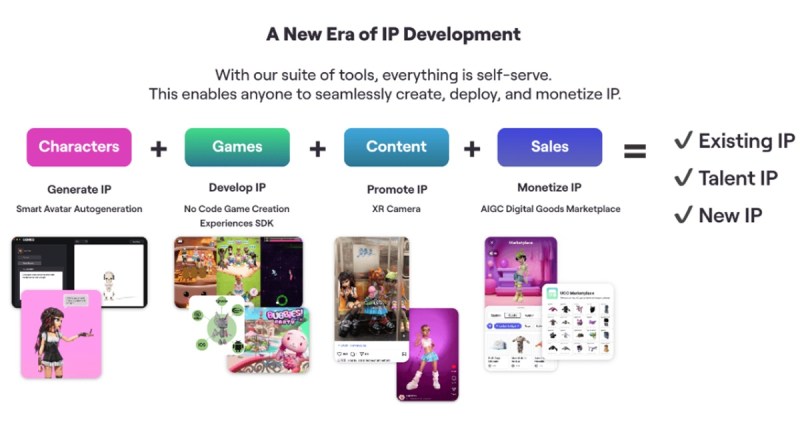
Up until now we’ve talked about existing IP and existing TALENT that can bring their IP to life in new ways.
Existing IP – Established IP owners and brands leveraging Genies’ tech stack to bring their IP to life through their own Smart Avatars and Party.
Talent IP – Influencers, creators, or celebrities developing their own digital identity through their own Smart Avatars for Party experiences.
However, once all of these tools are fully self-serve, this will usher in an era of creating brand new IP, enabling anyone to seamlessly create, deploy, and monetize IP all from their couch.
New IP – Anyone can develop original content and characters leveraging Genies’ UGC tech to generate new, re-imagined, or fictional IP as Smart Avatars for Party experiences.
Key elements of IP development process
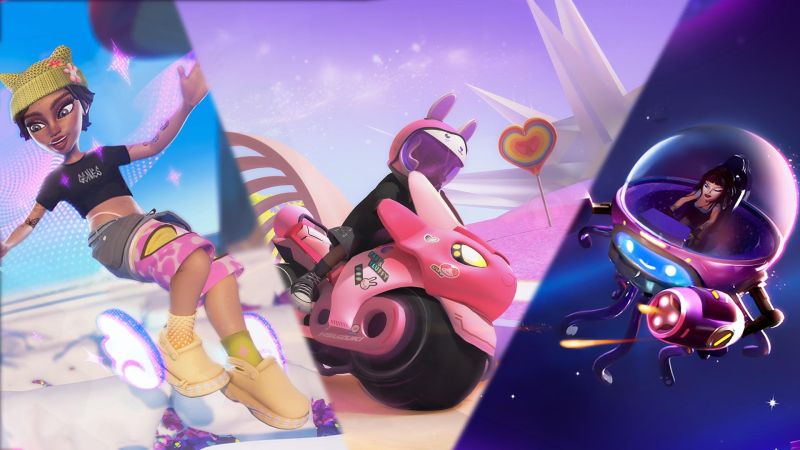
Generate smart avatar IP
Technology: Smart Avatar Autogeneration
Purpose: Anyone can create intelligent, customizable avatar-based intellectual property (IP). AI-powered tools assist in the creation process, making it easier for anyone to develop unique AI Smart Avatars.
Develop IP
Technology: No Code Game Creation + Experiences SDK
Purpose: This phase involves refining and expanding the generated IP using AI tools and Genies’ Experiences SDK (Software Development Kit) that allows users to develop interactive and immersive experiences with smart avatar IP.
Promote IP
Technology: XR Camera
Purpose: Users can showcase and market their IP using Genies Camera, a tool designed to generate engaging and customizable avatar content in order to drive distribution.
Monetize IP
Technology: AIGC Digital Goods Marketplace
Purpose: The final step allows users to commercialize their IP within Genies’ Asset Marketplace, where digital assets can be sold, traded, or used in various experiences.
This system empowers individuals and businesses to build, promote, and profit from their unique digital IP, expanding the possibilities for UGC-driven gaming, digital avatars, and virtual economies.
New IP development example:
Step 1: Generate Smart Avatar IP: Alex, a college student and aspiring digital artist develops their own Smart Avatar persona around a character they call “Neon Nova”. Using Genies’ Autogeneration and AIGC tools, entering prompts like “Cyberpunk rockstar with neon tattoos and futuristic streetwear” they are able to develop the look and feel of Neon Nova, and leveraging Genies’ personality and behavioral AI tools, they transform Neon Nova into a charismatic but mysterious personality, equipped with its own distinct look, voice, backstory, and persona.
Step 2: Develop IP: With Neon Nova ready, Alex utilizes Genies’ No-Code Game Creation tools and Experiences SDK to build an immersive “CyberCity Music Festival” Party App experience. In this virtual event, Neon Nova performs interactive concerts and engages in quests with users. Users help shape Neon Nova’s evolving story through their interactions.
Step 3: Promote IP: Alex leverages Genies’ Camera to capture dynamic content featuring Neon Nova performing songs and interacting with fans. Alex posts these shareable moments across social media platforms like TikTok, Instagram, and X (Twitter), effectively growing Neon Nova’s fanbase through its online personality and driving user adoption for the Party app experience.
Step 4: Monetize IP: To monetize, Alex designs and sells exclusive digital merchandise and collectible accessories for Neon Nova using Genies’ AIGC Digital Goods Marketplace. Fans purchase Neon Nova-inspired digital fashion, music packs, and unique collectibles to use within Party Apps or trade among friends, generating a revenue stream for Alex and expanding Neon Nova’s IP.
A no-code world
In past years, around 2021, it used to take about eight weeks to generate a game-ready 3D character, Nigam said. “Because we’ve created our own proprietary data set over the past five years, generating all of these Genies in this stylized motions, we can now auto generate them.”
Nigam showed me how he could create a fantastical character based on a celebrity.
“We used to make 20 avatars a year,” he said. “Now we can make 10,000 by Friday.”
At the moment, Genies supports bipedal avatars.
“Our vision is that this year we’re going to be able to accept quadrupeds, so dogs and cats and so forth. But for right now, a user can go ahead and generate a model as a game ready asset of a bipedal turtle, Samurai, whatever you just want to do,” he said. “And this can be another character that a user or anyone could use. The key is that the fashion that is also created in this ecosystem.”
Genies does all the work on auto-rigging and animating the characters.
“A huge aspect of this category has been empowering developers to create compelling experiences that can be published within this Super App, and also enabling non-technical kids to be able to create really fun, personalized, beautiful mini games as well,” Nigam said. “It can be done in a no-code way, and the only reason this is possible because we took so long to do all of this work.”
Recap
This first look at Genies’ AI avatars, game tools, and UGC platform they’ve spent years building makes one thing clear: they’re not just building avatars—they’re building the foundation for the next era of digital experiences.
Rooted in Genies two core mantras—“Anyone can create anything” and “Everything works with everything”—the Genies tech stack fuses AI, gaming, and interoperability to unlock limitless creativity and connection. By combining AI-powered creation tools, interoperability frameworks, and fully interactive, interoperable AI avatars, Genies is redefining how online identities, social games, and digital creation can be brought to life.
“We’ve already started to sign massive partners, which is super rewarding. Obviously, it’s been a long time, but we’ve already started to sign them on. We’re going to be making some announcements about them over the next few months,” Nigam said. “There is a whole strategy that’s going to be put into place, depending on the partner. They’ll roll it out at different times. We won’t reveal that yet, but it’s not far off.”
GB Daily
Stay in the know! Get the latest news in your inbox daily
Read our Privacy Policy
Thanks for subscribing. Check out more VB newsletters here.
An error occured.



